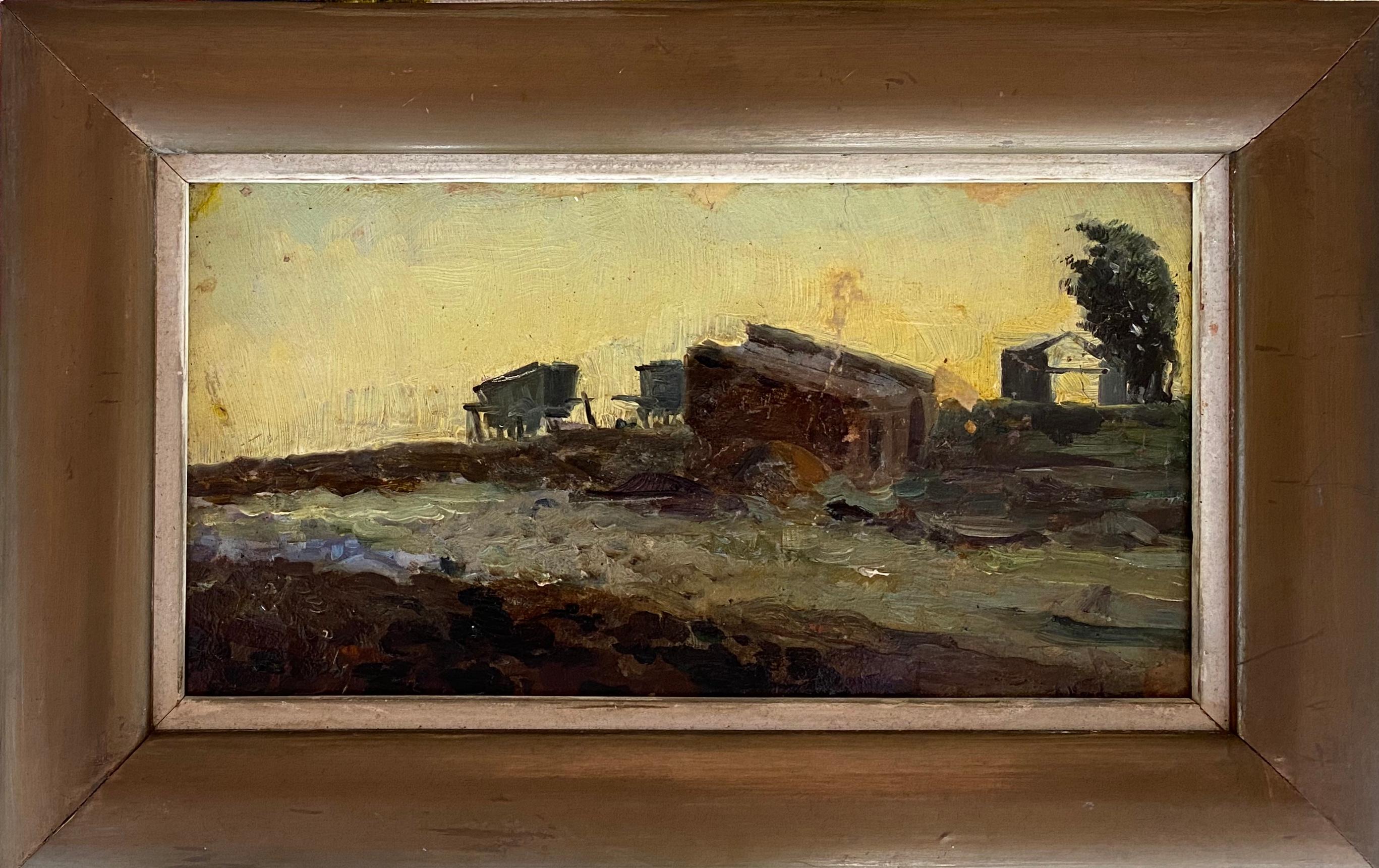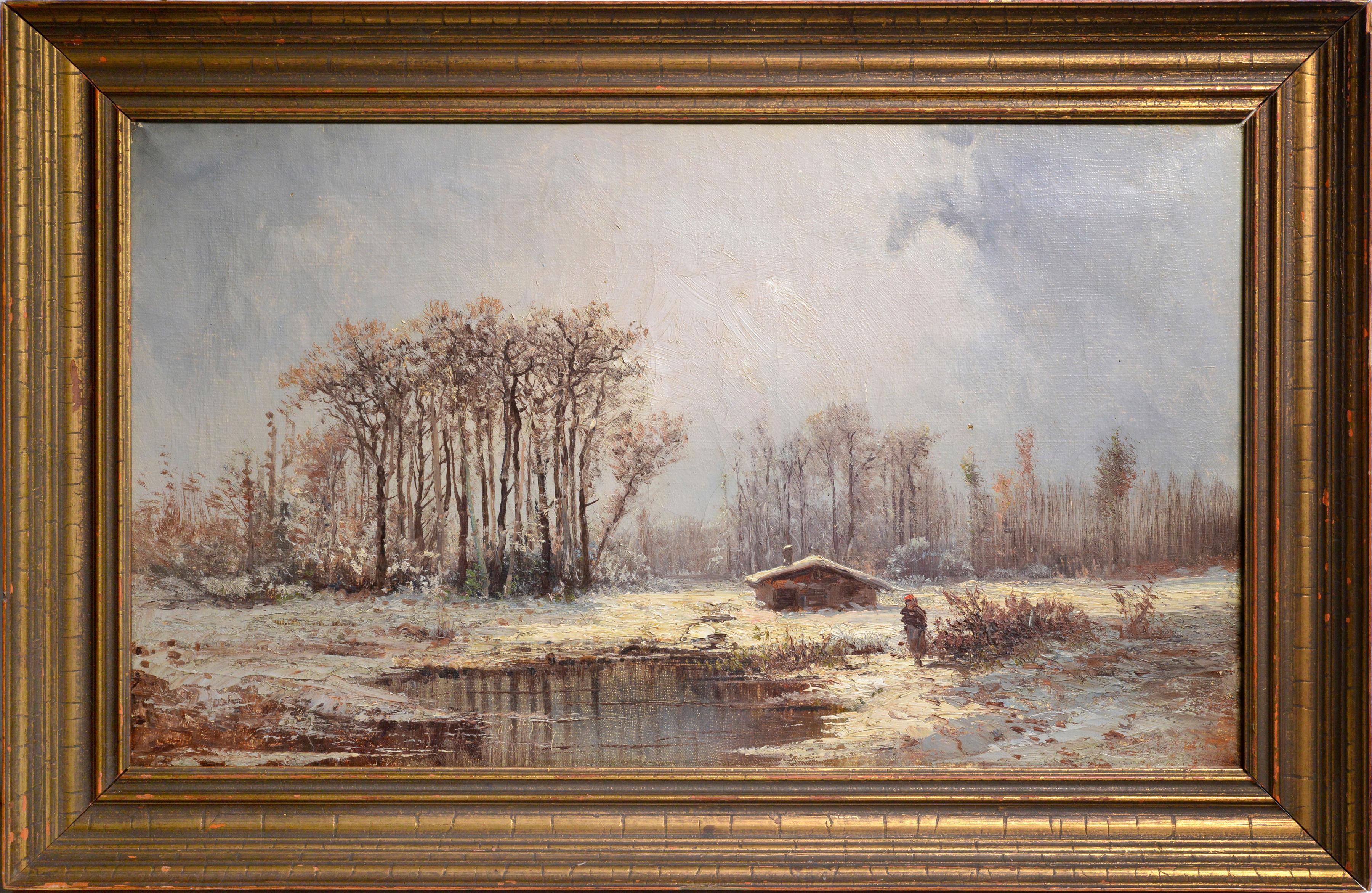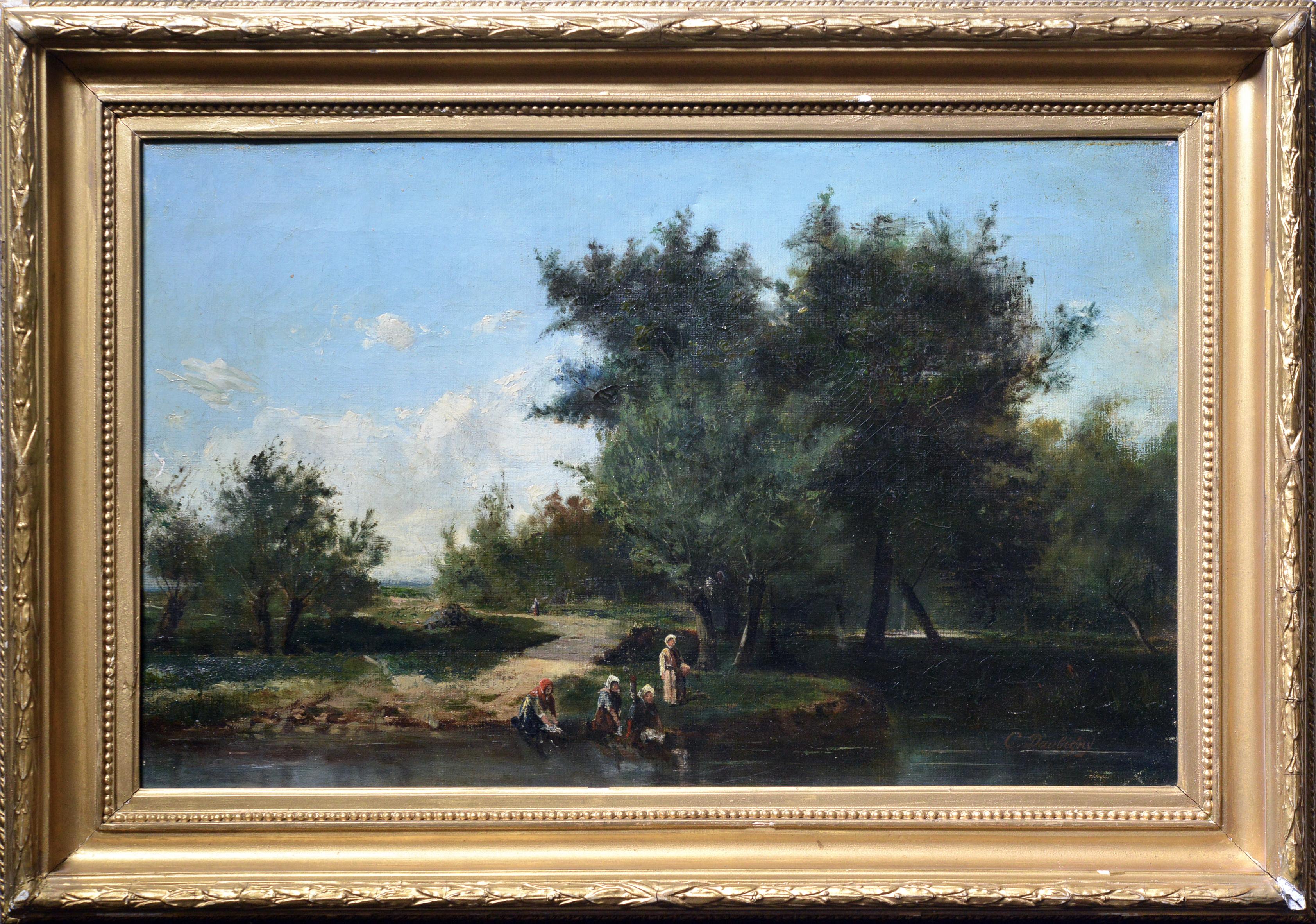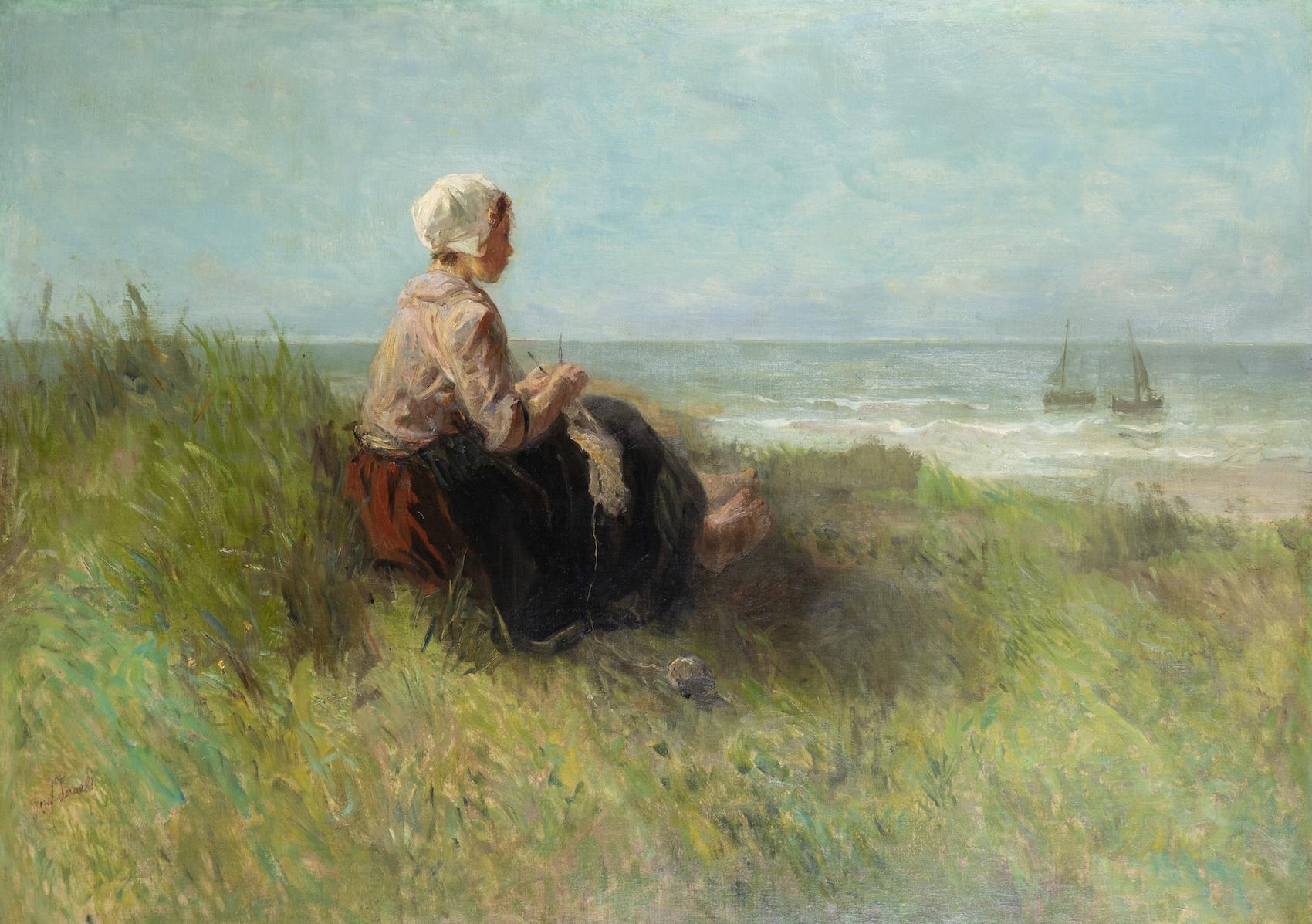Items Similar to Sunset, an emblematic painting by Théodore Rousseau inspired by Barbizon
Want more images or videos?
Request additional images or videos from the seller
1 of 11
Théodore RousseauSunset, an emblematic painting by Théodore Rousseau inspired by Barbizon
About the Item
While an exhibition is currently celebrating the work of Théodore Rousseau at the Petit-Palais in Paris, we are delighted to present this work, which is entirely emblematic of his art: from 1847 onwards, the depiction of a dense forest in its primeval state became one of the artist's favorite subjects.
The title "Sunset" emphasizes the role of autumnal light illuminating a clearing in the late afternoon. In this view, probably inspired by the forest around Barbizon, Rousseau's palette offers a rich chromatic range, heightening the golden browns with powerful blacks underlined by a few clear touches. Drawing inspiration from Rousseau's fresh look at nature, and pursuing his research about light, the next generation of artists will invent Impressionism.
1. Théodore Rousseau, the voice of the forest
Théodore Rousseau was born in 1812 in Paris, the son of a tailor from the Jura region. Sent at thirteen to his father's native province, he learned to know and love the forests of the Jura. On his return to Paris, having decided to become a landscape painter, he studied briefly with Charles Rémond (1795-1875), a painter of historical landscape, whose instruction he found unhelpful and whom he left, in 1828, for another, no less academic, master, the history painter Guillon-Lethière (1760-1832). In 1829 he vainly tried to enter the academic competition for the Rome Prize for Historical Landscape. The following year, on a tour in the Auvergne, he painted his earliest, distinctly personal landscape studies, on which in 1831 he based his first Salon entry. In 1834, a landscape of "Dutch" character, Edge of the Forest at Pierrefonds, was bought by the duc d'Orléans and won him a medal at the Salon.
He had meanwhile joined a bohemian clique gathered around Théophile Thoré, an early socialist and future art critic. Rousseau's association with these eccentrics and dissenters irritated the Salon authorities, who retaliated by rejecting his submissions. On a tour in the Jura in 1835 he conceived a vast, crowded composition, Descent of the Cattle from the Meadows, that occupied him for a year; it was emphatically rejected by the Salon of 1836. More rebuffs in the following years discouraged him from entering further work. Finding the Salon closed to him, he shifted to saleable subjects of modest scale, treated in a naturalist style. In search of motifs, he visited the forest of Fontainebleau, staying at Chailly in 1834 and, at Barbizon in 1836. In The Avenue of Chestnuts (Louvre - fifth picture in the gallery), painted during 1837-1840, he composed a symmetrical view, animated by the writhings of interwoven branches that form a natural architecture.
With Jules Dupré (1811-1889), his friend and painting companion in the 1840s, he explored the spacious plains of the Berry and Landes regions. During 1845 and 1846 he shared a studio with Dupré in L'Isle-Adam. A contented bachelor until then, he was brought to the brink of matrimony in 1847 by the novelist George Sand who offered him the hand of her adopted daughter. Gossip, which Rousseau blamed on Dupré, frustrated the match. Deeply resentful, he withdrew to the village of Barbizon at the edge of the forest of Fontainebleau, accompanied by an ailing woman, Eliza Gros, with whom he shared the rest of his life. For purposes of business he kept a Paris address.
The Revolution of 1848, in which he took no active part, temporarily broke the power of academic juries. A committee of artists, including Rousseau, took charge of the liberated Salon. The government of the new Republic, to make amends for past neglect, asked him for a picture on a subject of his own choice. The result was the large and rather formal View of the Forest of Fontainebleau: Sunset (Louvre - 6th picture in the gallery). In 1849, at his first Salon in fourteen years, he showed three paintings and was given a gold medal; but Dupré, who had exhibited nothing, received the cross of the Legion of Honor. This ended their friendship.
Jean-François Millet, who had moved to Barbizon in 1849, now took Dupré's place in Rousseau's life. Appointed to the Salon jury in 1850, Rousseau exhibited seven paintings that year. The Legion of Honor at last accepted him following the Salon of 1852. The following years were an interlude of prosperity in his life. At the Universal Exposition of 1855, which he had helped to jury, his entry of thirteen paintings won a triumphant success. But a reaction soon set in. At the Salons of 1857-1863 his paintings were coldly received. The demand for his work slackened; sales held in 1861 and 1863 produced poor results. Rousseau lived in a state of nervous excitation, haunted by creditors and depressed by his wife's gradual decline into insanity. In 1866 large purchases by the dealers Brame and Durand-Ruel temporarily restored his finances. Later that year, he was elected president of the art jury for the Universal Exposition of 1867, and at its close received the Grand Medal of Honor. But, unlike other members of the jury, he was not made an officer of the Legion of Honor. The emperor himself ultimately repaired this slight, but the exasperation it had caused Rousseau broke his health. Cared for by Millet, he died in his cottage at Barbizon in December 1867.
Rousseau's naturalism was the product of meditative study, not rapid transcription: incapable of spontaneity, he doggedly reworked his pictures in the studio. He understood nature as a process of constant growth and dissolution and thought of trees as fellow creatures, each marked by its own fate and struggle. Solitary, pious without religion, a materialist romantically in love with nature, he sought in his work to reconcile emotional empathy with objective sight.
2. Description of the artwork
The painting we present is typical of Rousseau's research into the representation of the forest, and particularly the dense, undeveloped forest, which became one of his favorite subjects from 1847 onwards.
Beyond a clearing with a shimmering pond in the foreground, a path leads into the forest between two tall, broken trees. A walker, perhaps gathering bundles of wood, is evoked by a red spot, giving us the scale of these imposing trunks. By reducing the size of this human figure and monumentalizing the nature around her, Rousseau demonstrates a new understanding of man's place in the cosmos.
On the left, a large boulder next to a group of oaks with gnarled branches indicates that we are in the Fontainebleau forest; this is one of the artist's favorite motifs, which we find again, for example, in The forest in Winter at Sunset (last picture in the gallery). This painting, inspired by the forest of Bas-Bréau near Barbizon, was probably begun around 1845-1847, but remained unfinished in the artist's studio at the time of his death.
Our painting bears witness to the unitary, pantheistic conception of Rousseau, who lived in mystical communion with the forest. "For him, trees have a soul, so much so that he considers the drawings he makes of them as portraits" . This naturalistic concern is reflected here in the careful description of the two broken trees in the center of the composition, which contrast in their tragic bareness with the majesty of the two oak trees on the left, as if sheltered behind a large boulder.
3. Provenance and framing
This painting comes from the personal collection of Paul Touzet (1898 - 1981). Between the wars, he opened his first gallery on rue de l'Université. He then moved to rue des Beaux-Arts, where he mainly exhibited Dutch and Flemish paintings. In the 1960s, his main activity became that of expert at public auctions, and he remained one of the most renowned experts in Paris until his death in 1981.
Our panel is presented in a rich neo-Louis XIII frame, typical of late 19th-century production and the framing given to paintings by the Barbizon painters, a name later used to designate this type of framing.
Main bibliographical reference
Théodore Rousseau la voix de la forêt - catalog of the Petit Palais exhibition, edited by Servane Dargnies - de Vitry - Editions Paris Musées 2024
Exhibition: Le Paysage français de Corot à nos jours, Galerie Charpentier 1942 - number 156 (from a label on the back)
- Creator:Théodore Rousseau (1812-1867, French)
- Dimensions:Height: 12.63 in (32.09 cm)Width: 14.38 in (36.53 cm)
- Medium:
- Movement & Style:
- Period:
- Condition:7 ½” x 9 ½” (19 x 24 cm) - Framed 12 5/8” x 14 3/8” (32 x 36.5 cm) Signed lower left "Th Rousseau". The attribution to Théodore Rousseau has been confirmed by Michel Schulman, an expert in the artist's work.
- Gallery Location:PARIS, FR
- Reference Number:1stDibs: LU1568214269382
About the Seller
5.0
Vetted Seller
These experienced sellers undergo a comprehensive evaluation by our team of in-house experts.
Established in 2020
1stDibs seller since 2021
8 sales on 1stDibs
Typical response time: 2 hours
- ShippingRetrieving quote...Ships From: PARIS, France
- Return PolicyA return for this item may be initiated within 3 days of delivery.
More From This SellerView All
- Stag Hunting in the Vicinity of Nuremberg by a German Artist Peter von BemmelLocated in PARIS, FRThis small landscape shows a hunting scene: two riders are chasing a stag with their dogs at the edge of a forest. Signed by Peter von Bemmel, it is typical of the production of this...Category
1720s Old Masters Landscape Paintings
MaterialsCopper
- Italian Landscape with Jack Players, a painting by Gaspard Dughet (1615 - 1675)By Gaspard DughetLocated in PARIS, FRHere Gaspard Dughet offers us an idyllic vision of the Roman countryside. The stages follow one another in a perfectly structured composition, revealing here a lake, there travellers walking along, gradually leading our eye to the blue horizon. But behind its classical composition, this landscape is particularly interesting because of three anthropomorphic details that the artist has hidden, opening the way to a radically different interpretation... 1. Gaspard Dughet, a landscape artist in the light of Poussin Gaspard Dughet was born on June 4th, 1615 in Rome where his father, of French origin, was a pastry cook. He was probably named Gaspard in honour of his godfather Baron Gaspard de Morant, who was, or may have been, his father's employer. His older sister Jeanne married the painter Nicolas Poussin (1594 - 1655) on September 1st, 1630. The young Gaspard was apprenticed with his brother-in-law at the beginning of 1631, which led his entourage to name him Gaspard Poussin. The first preserved works of the painter date from the years 1633-1634 and were painted in Poussin’s studio. Around 1635, Gaspard Dughet became emancipated and began to frequent the Bamboccianti circle. In 1636, he became friends with the painter Jean Miel (1599 - 1656), but also with Pier Francesco Mola (1612 - 1666) and Pietro da Cortona (1596 - 1669). This was also the time of his first trips throughout Italy. The painter, although of French origin, appears never to have visited France. In 1646 he settled permanently in Rome. A recognized painter with a solid book of orders, he remained faithful to landscape painting throughout his life, alternating between cabinet paintings and large decorative commissions, using both oil and fresco. Nailed to his bed by rheumatic fever at the age of 58, he died on May 25, 1675. 2. Discovering an idealized landscape Beyond a relatively dark foreground that takes us into the landscape, we discover a vast bluish horizon: a plateau surrounded by deep ravines advances to the right, overhanging an expanse of water that sparkles below. A road winds through a mountainous mass as if leading us to the fortress that crowns it; another town appears in the distance at the foot of three conical mountains. The composition is rigorous, mineral, and structured by geometric volumes. The various stages in the landscape lead one to the next attracting the eye towards the horizon located in the middle of the canvas. The general impression is that of a welcoming and serene nature. In many places the paint layer has shrunk, or become transparent, revealing the dark red preparation with which the canvas was covered and accentuating the contrasts. Human presence is limited to three jack players, leaning against a mound in the foreground. Their long garments, which may evoke Roman togas, contribute to the timelessness of the scene. Close examination of the canvas reveals two other travellers on the path winding between the rocks. Made tiny by the distance, their introduction in the middle register, typical of Dughet's art, lengthens the perspective. While it is difficult to date the work of a painter who devoted his entire life to the representation of landscapes, it is certain that this painting is a work from his later years. The trees that occupied the foreground of his youthful compositions have been relegated to the sides, a stretch of water separates us from the arid mountains counterbalanced by two trees represented on the opposite bank. The introduction of this stretch of water in the middle of the landscape betrays the influence of the Bolognese and in particular of the Dominiquin (1581 - 1641) A number of similarities with a drawing in the British Museum might suggest a date around 1656-1657, since, according to Marie-Nicole Boisclair , it has been compared with the Prado's Landscape with the Repentant Magdalene, painted at that period. 3. Three amazing anthropomorphic details While some late Renaissance landscapes offer a radical double reading, allowing one to see both a face or a human body behind the representation of a landscape, it seems interesting to us to hypothesize that Gaspard Dughet had fun here by slipping in a few details that, taken in isolation, evoke human or animal figures. We will give three examples, looking closely at a cloud, the trunk of a broken tree and the top of a cliff. The main cloud could thus evoke a Christ-like face or that of an antique god...Category
1650s Old Masters Landscape Paintings
MaterialsOil
- The Departure of the Vendéens, an oil on carboard by Pierre-Paul Prud'honBy Pierre-Paul Prud'honLocated in PARIS, FRProvenance: Alfred Stevens Collection Sold by Madame Blanc on May 3, 1876 (number 24 representing The Departure of the Vendéens, FRF 510, bought back by Madame Blanc). Paul Touzet (...Category
1790s Old Masters Figurative Paintings
MaterialsOil, Cardboard
- The Arrival of the Storm, a painting by the school of Claude-Joseph VernetBy Claude-Joseph VernetLocated in PARIS, FRDuring his stay in Italy from 1734 to 1752, Joseph Vernet made several trips to Naples between 1737 and 1746, where he painted numerous maritime scenes. The pre...Category
1770s Old Masters Landscape Paintings
MaterialsOil, Canvas
- The Parade of Swiss Guards a painting on canvas by Gabriel de Saint-AubinLocated in PARIS, FRIn this painting, Gabriel de Saint-Aubin, the great chronicler of the reign of Louis XV, takes us to the annual parade of the Swiss Guards at the Plaine de...Category
1760s Old Masters Figurative Paintings
MaterialsCanvas, Oil
- River Landscape with Shepherds and Architecture, a painting by Jan van BunnikBy Jan van BunnikLocated in PARIS, FRThis painting has been the subject of a study by the art historian Fabrizio Dassie (available on request), confirming its inclusion in Jan van Bunnik’s corpus. In this painting, Ja...Category
Late 17th Century Old Masters Landscape Paintings
MaterialsCopper
You May Also Like
- Corot student Barbizon landscape with Figure French 19th Century oil paintingLocated in Norwich, GBA wonderful rural scene of a woman walking at sunset in a wide landscape, imbued with almost magical light. It is a work by French artist Pierre-Ernest Ballue, who had studied painti...Category
Late 19th Century Barbizon School Landscape Paintings
MaterialsOil, Wood
- The Sand Barge by Jozef Israëls - Landscape painting, Dutch artist, Hague SchoolBy Jozef IsraëlsLocated in London, GBThe Sand Barge by Jozef Israëls Oil on wood panel. 18 x 40 cm (7 1/16 x 15 3/4 in). Signed Artist biography Dutch-Jewish artist Jozef Israëls was born ...Category
Late 19th Century Barbizon School Landscape Paintings
MaterialsOil, Wood
- “French Countryside at Dusk”By Raymond Jean VerdunLocated in Southampton, NYOil on heavy card stock laid down on masonite by the French artist, Raymond Jean Verdun. Signed lower right. Circa 1895. Condition: Good. Overall framed 7 by 11 inches. The frame has been restored. Born 1873, in Nogent-le-Rotrou; died 1954...Category
1890s Barbizon School Landscape Paintings
MaterialsMasonite, Paper, Oil
- Spring Thaw Barbizon Landscape 19th century Oil painting by French ImpressionistBy Emile GodchauxLocated in Stockholm, SEOne of early of the French artist’s works by Emile Godchaux (fra.: Émile Godchaux, 1860 - 1938), late 19th century. This amazing landscape takes us to a cloudy spring day, making us ...Category
Late 19th Century Barbizon School Landscape Paintings
MaterialsCanvas, Oil, Wood
- Laundresses on River 19th century Barbizonian Landscape by French MasterLocated in Stockholm, SESigned lower right "C. Daubigny". As we gaze upon the painting, we are immediately drawn to the foreground, where a small group of women are diligently washing clothes on the banks o...Category
Mid-19th Century Barbizon School Landscape Paintings
MaterialsCanvas, Wood, Cotton Canvas, Oil
- Waiting by Jozef Israëls - Landscape oil paintingBy Jozef IsraëlsLocated in London, GBWaiting by Jozef Israëls (1824-1911) Oil on canvas 95.3 x 133.9 cm (37 ½ x 52 ¾ inches) Signed lower left, Jozef Israels A monumental painting by one of...Category
19th Century Barbizon School Figurative Paintings
MaterialsCanvas, Oil
Recently Viewed
View AllMore Ways To Browse
Antique Architecture Painting
Red Antique Landscape
Broken Woman
Live Oak Art
Emperor Painting
Artist Rousseau
Large Scale Painting Antique
Antique Sand Art
Barbizon School Of Painting
Barbizon Oil Painting
Barbizon Oil
Salon Style Set Of Art
Landscape Oil Paintings By Dutch School
19th Century Impressionism Paintings
Barbizon Painters
Paris Sunset
Barbizon Frame
Antique Barbizon Painting





